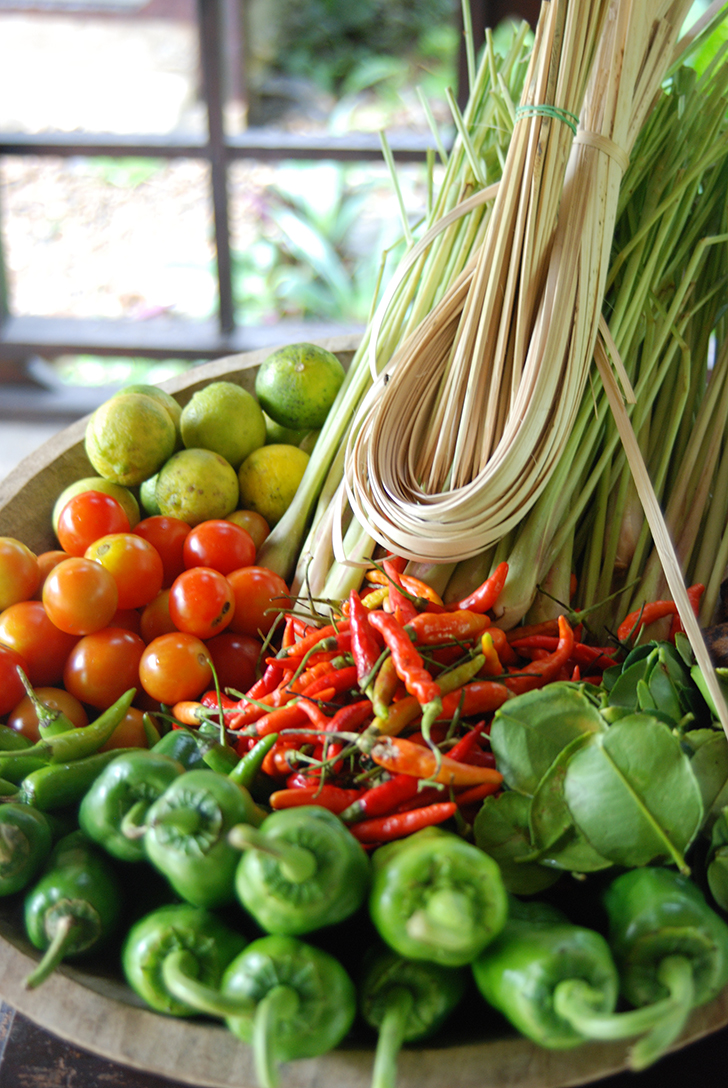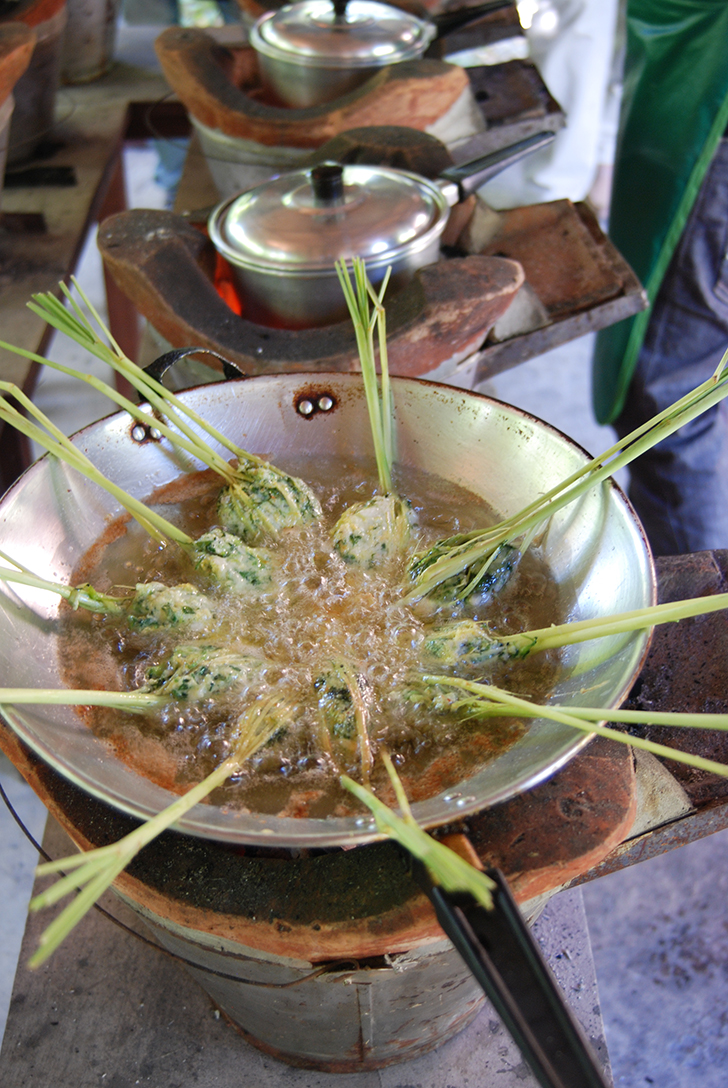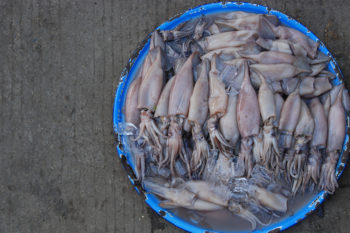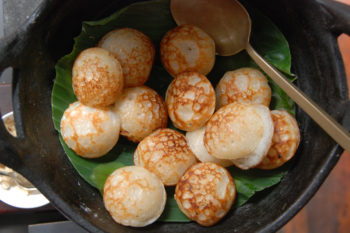Laos spices things up with unique cuisine. Read about how this small Southeast Asian nation turns up the heat with big, bold flavours.
The irony of Joy’s name doesn’t escape me as he sighs and trudges over to my cooking station to show me, once again, how to stuff the ground chicken mixture into the cut stalk of lemongrass. In all fairness, Joy is a Lao chef and cooking instructor, not a saint.
Moments earlier I had been happily exuding the confidence of a domestic goddess in pulverizing the meat with herbs via mortar and pestle, discovering my knack for culinary skills that require only brute force. Anything that requires dexterity, delicacy, finesse, coordination or patience however. . .
Buzz from travellers about Tamarind Restaurant’s cooking class flew around Luang Prabang’s easy-going and placid streets, chatter tagged with words “authentic” and “real local food”. For $29 U.S. the course includes a morning market tour, the chance to make (and eat) six dishes and an education in the food of Laos.
And an education is needed. Lao cuisine is mysterious.

Starting half an inch from the bottom, Joy runs the tip of the knife down the centre of the woody, pale yellow stalk, rotating and repeating the cut several times. He opens up the lemongrass to form a little cage, artfully stuffs the filling inside and plops it on the plate ready for the deep fryer. No goopy mess. No oozing out the sides. Everything is neat and self-contained. Now my turn.
The result is both a comedy and a tragedy.
Joy sighs and moves on to show the group the next dish. I reassure my ego that the Ua Si Khai will all be the same in the end: deep fried and delicious.
I can’t imagine a nicer setting to fail at making Ua Si Khai. We are a 15-minute tuk-tuk drive outside the city’s tourist centre in lush and tranquil countryside. The class is held beside a small lake where the tilapia was caught for our Mok Pa, whitefish filets wrapped in a banana leaf with an herb marinade and steamed. The outdoor pavilion holds individual cook stations, fully outfitted, and one head demonstration table loaded with the fresh herbs and flavours essential to Lao cuisine: coriander, galangal, kaffir lime, basil, mint, dill, chili, garlic, ginger and fish sauce.
Lucky for me, most Lao dishes are not as fussy to prepare as Ua Si Khai.

Lao cuisine is all but unknown to the outside world, especially when compared to the cuisine of the country’s Southeast Asian neighbours. To use a popular local expression, I assumed Lao food would be “same-same” as Thai or Vietnamese. How wrong I was.
Absent are the heavy and oily coconut milk-based curries of Thai cuisine, or the prominence of French food as in Vietnam. In spite of a hundred-plus years of French rule, the colonizers’ food never sank in here (although the scrumptious baguette can still be found all over Laos — thank goodness).
Unlike Laos’ neighbours, mint and dill are used. Sweetness is never added to savory. Dishes are commonly eaten at room temperature and served with raw, undressed greens as a side. Lao cuisine is low key yet refreshingly unique.
The mortar and pestle is an essential tool in a Lao kitchen for extracting those flavours. I blissfully bash my way to foodie heaven making starter Jeow Mak Keua, an eggplant dip. We roast the eggplant over hot coals, remove the blackened skin then pound it with green onions, cilantro, garlic and chili until it achieves a silky texture. Infused with subtle smokiness and some spicy kick, it tastes marvelous.
I smash the contents of my mortar with even more gusto for Jeow Mak Len, a fiery tomato salsa.

Lao cuisine is not about being timid, not about cajoling ingredients, not cooking as if one is coaxing a kitten out of the closet with Motherese. The flavours are bold, bright, at times brash, but always fresh. I already know the meat stew Orlarm, currently simmering away, will be controversial with this cooking group’s palate. A signature dish of Luang Prabang that traditionally took advantage of the wild bounty available in the Mekong jungle, the aroma wafting from the pot is almost medicinal.
Pea eggplants, cloud ear mushrooms, local basil and dark leafy greens were just a few of the ingredients thrown into the pot. Orlarm is conventionally made with water buffalo, but Joy offered the group the alternative of chicken. I’ve opted for the real thing, adding fat, leathery pieces of dried water buffalo skin and meat.
The most distinctive ingredient in this dish is sa khan, also known as chilli wood. It is quite literally wood. Joy had pointed out the small logs of the thick vine during our market tour. It tastes of peppercorn, chili spice and a bracing bitterness that left me coughing and munching on tomatoes as a remedy. It also made the inside of my mouth tingle, then go slightly numb to boot.
But what really defines Lao food and the way it is eaten is the staple, sticky rice.
Also known as glutinous rice (describing the consistency not ingredient — it is gluten-free), the special variety of short-grain rice is soaked in water for several hours and steamed in a bamboo basket. The result is rice that is dry but whose grains stick together.
Sticky rice is the heart of every meal and defines all Lao eating customs and habits. Eaten with fingers (the consistency makes it difficult to eat it any other way) food is made the way it is to suit this method. We sit at a big family table and learn the proper way to dig in.

With a clean hand we gather a small amount of the rice with our fingers and knead it into a ball. It becomes the perfect vehicle for dips and sauces. We use it to pick up the eggplant dip, to sop up the tomato salsa. Using the sticky rice ball like one would use a piece of bread, we scoop and pinch flaky morsels of fish with our thumb and pop it into our mouth. In essence, eating with the hands is a literal show of the tactile relationship Laotians have with their ingredients and their food. To honour the communal nature of Lao meals, we even sample one another’s dishes and exchange praise.
And while my unpretty Ua Si Khai will never grace the cover of Saveur magazine or be up to snuff in Hell’s Kitchen, it tastes darn good — if I may say so myself.
This story was originally published in The Toronto Star.

